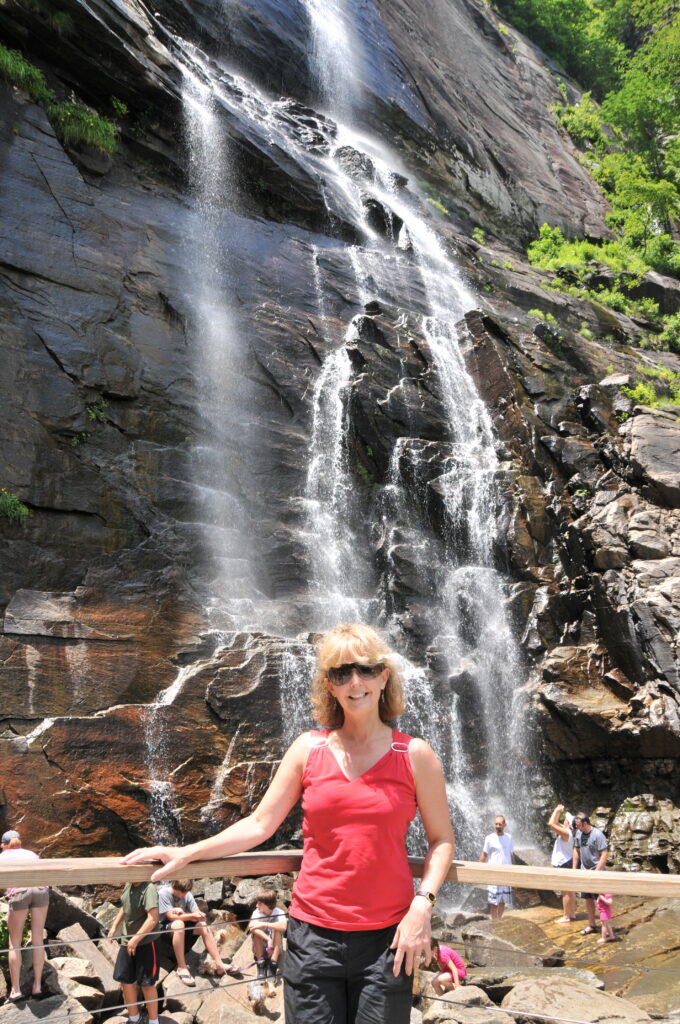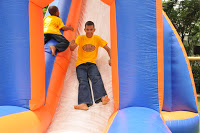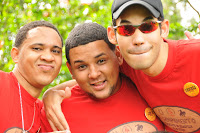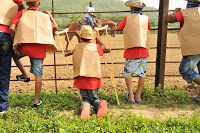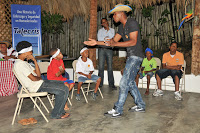Laurie Kelley
June 13, 2010

 Friday was an astonishing experience. Our ultimate goal was to meet Mitch, the only known person with hemophilia in Haiti. He lives about 90 minutes away, and first we had a few stops to make for more deliveries from Randy Moore, the nurse who works at St. Francois de Sales, where I am staying for two days while in Haiti. Our ultimate goal is to establish a hemophilia referral and care system. While most of the countries of the world have some kind of hemophilia care, Haiti has been left in the dust. The earthquake seemed to rattle everyone’s attention. With outpourings of help that cannot be used due to lack of a program, I’ve decided that it’s time Haiti join the rest of the world to get the hemophilia care it deserves. But first we must find the patients.
Friday was an astonishing experience. Our ultimate goal was to meet Mitch, the only known person with hemophilia in Haiti. He lives about 90 minutes away, and first we had a few stops to make for more deliveries from Randy Moore, the nurse who works at St. Francois de Sales, where I am staying for two days while in Haiti. Our ultimate goal is to establish a hemophilia referral and care system. While most of the countries of the world have some kind of hemophilia care, Haiti has been left in the dust. The earthquake seemed to rattle everyone’s attention. With outpourings of help that cannot be used due to lack of a program, I’ve decided that it’s time Haiti join the rest of the world to get the hemophilia care it deserves. But first we must find the patients. 
Staying at the house at the St. Francois compound is a bit like being at a college dorm, only with much better food. I awaken at 5:30 am to birds squabbling in the tree outside my open window. A grab a cold shower, and then Randy and I have a breakfast of eggs and cassava, and I feel the heat rising, like an oven being stoked. (Photos: Randy in the medical storeroom; our chariot)
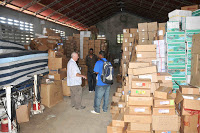

Part of what we did for two days was to meet the people who might help us set up a referral system, to get patients referred to Randy. One of these people is Dr. Eugene Maklin, a general physician with a heart of gold and a dazzling smile, and it seems he always has a smile. He is highly regarded by all in Cap-Haitien. For this trip today, Friday, we pick him up as well as our translator, a handsome 28 year old named Jorgen, who happens to be a big Lakers fan.
Roads are one of the biggest detriments to health care: decayed, pocked, crumbling, with billows of dust that almost obscure pedestrians. There are no rules to the road, Randy says. No median strips, no painted dividers. Garbage borders the streets like some strange edging on the fabric of poverty. You come to expect to see it but I am surprised when two city blocks have clean edges—no sidewalks or any such convenience of course. But the garbage is gone. 
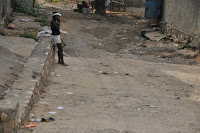
We’re jostled back and forth, up and done—taking a video is impossible—and finally we hit a highway, with smoother terrain. We pick up speed. Eventually the road deteriorates again and we doge potholes and motorbikes, popping over speed bumps. I start to feel ill and nauseated. I love speed rides but this is like the Runaway Train in Frontierland on drugs.(Photo: Nate Nickerson of Konbit Sante with Dr. Maklin, Randy and Jorgen)
An hour later we arrive in Jacquesyl, a quiet hamlet, one of hundreds in Haiti. It’s flat, scorching, and estimated to have 12,000 people. But who really knows? There is no census in Haiti and all demographics are estimates only. There are few trees, just brush, and dirt and dust everywhere. It’s very rustic.
The homes are made of branches fastened together with mud applied over them. Some have concrete. The roofs, as always, are corrugated tin, baking the inhabitants like dinner in a kiln.
We stop at the small clinic where Dr. Maklin works every Friday. Every Friday he makes this trip by motorbike. Going by car for him today is a treat; not for me.
As we walk into the rural clinic, which has just a few rooms and a short hallway where families are waiting, Jorgen says, “This is a nice place,” and he is sincere. “It’s a nice town,” he adds, and he’s also sincere about that.
Mitch’s grandmother comes into the consultation room. She is rail thin, about 65, elegantly dressed as though she were going to go to church. This always amazes me about the Haitians: how they can look so nice all the time in their clothes, so presentable despite the heat, humidity and dust. She asks in Kreyol who donated the medicine for Mitch and everyone points at me. She smiles and embraces me.

We head off to see Mitch, who is in school, only about 300 feet away. Mitch cannot walk at all. He uses a wheel chair or is carried everywhere. We find the 10 year old sitting in his antiquated schoolhouse, surrounded by his curious classmates. He’s the only known person with hemophilia in the country.
Thin, handsome in his blue school uniform, he looks at us not terribly impressed. Dr. Maklin explains why we are there; Mitch nods. Then we examine his knee, and see the ghastly scar running from top to bottom, resembling train tracks. I take out a gift bag of toys and hand them to him one by one: crayons, deck of cards, sunglasses, T-shirts and a huge superball. After some photos, we carry Mitch outside and place him in the ambulance. When I get in the passenger side, I am surprised to see Mitch sitting in Randy’s lap in the driver’s seat. Mitch has a cool, confident smile on his face and we take off, with Mitch steering and Randy’s foot on the brake and gas petal, cheered by the schoolmates who run alongside.
We arrive at his home momentarily. I snap a photo of his street and an elderly woman hobbles toward me, scolding me in Kreyol. It’s not culturally appropriate to take photos in Haiti: the Haitians do not want us to focus on their misery, their poverty. Randy diffuses the situation through Jorgen by telling her she’s so pretty, why not take a photo? She smiles and they put heads together for a photo. It turns out she is Mitch’s aunt and now we are all friends.
Mitch is placed in a chair in the yard and his wheelchair is brought out. It’s broken, and Randy pledges to get a new one. The house is nice by any Third World standards. A little porch, concrete, several rooms, a yard. I don’t see inside and imagine the inside is not as nice. More photos and Mitch gets the rest of the afternoon off from school.
We go back to the clinic, so Dr. Maklin can finish seeing patients. I become one of them. I am not feeling well and need to get out of the sun and rest. There are no gurneys, no couch, no privacy. I’m escorted to the hamlet’s parish, and inside find a nice living room. As I sit down in the hard sofa, I jump a little as next to it is a box with a huge spider on it. My escort, a pretty young Haitian woman, smiles at me sweetly, and swats it into oblivion.


An hour of peace, even in a room with no AC or fan, works wonder. A houseboy brings lukewarm Cokes in bottles but I can only manage 4 ounces. I give him the other 12 ounces which he refuses at first, incredulous, but then he gives in and walks away smiling.
By 2 pm Dr. Maklin is finished with the patients and we climb back into the ambulance. Two young boys watch us from the shade of one of the few trees. I only have one stick of gum and one mint left but motion for them to come. They race towards us, and grab the goodies.
Randy is compassionate; he drives only about 5 miles per hour, joking that we should reach Cap by tomorrow sometime. We are all happy and chatting about Mitch, and how we can structure hemophilia care, and somewhere along our get-to-know-you session, discover that Jorgen, Dr. Maklin, Randy and I all like Lady GaGa songs.
With only 20 minutes to go till we reach Cap, we stop at a cemetery to snap photos of the beautiful, pastel-colored tombs. Randy asks Jorgen jokingly if he’d like to go in and take one for us, but he shakes his head resolutely. Haitians believe firmly in spirits, and perhaps Jorgen doesn’t want to offend them.
Ten minutes later we pass a mob—something has happened. Quickly I see a truck, a man lying half under the truck, another man on the other side also lying half under, and blood. Men are swarming the truck and shouting they see us, an ambulance , and wave frantically. Randy pulls over, throws the siren on and backs up. The crowd grows; a few UN personnel stand by but do not get involved. Randy, Dr. Maklin and Jorgen jump out to assist. There’s nothing I can do but get in the way, so I stay in the front seat.
Apparently, the two men were on a motorbike together, and hit the truck. Neither is wearing a helmet, sadly a common practice in most developing countries. Both have severe head injuries. The back doors of the ambulance are swung open and Jorgen jumps in first as each man is clumsily handed to him. He lays them down on the metal floor; the bench seats are locked up. Dr. Maklin also gets in last and just before the doors are shut one of the UN guys snaps a photo of the chaos inside the ambulance.
The next 20 minutes are surreal. The two men, severely injured, lying side by side with Dr. Maklin trying to dress their wounds, and with poor Jorgen being tossed about as the ambulance rockets down the decayed and pitted streets. Randy is focused completely on moving traffic out of the way and taking the men to the public hospital that we just visited this morning. Was it this morning? Time moves so slow in Haiti that it felt like last week.
One man, tall and lean, keeps struggling to stand up, despite his wounds. His eyes are wild. “Couchez! Couchez!” (“Lie down!”) commands Jorgen, but Randy yells back not to bother; the man is delirious and doesn’t know what he is doing. The man gives up and pillows his head on a metal box. The conch shells we collected at the beach smash about and I try to pull them up front, to stay away from the injured men.
The second man lies flat on his back, moaning. He is black, of course, but his arm is white now. The skin has been completely stripped off, known as “degloving,” exposing white underneath; muscle fascia, tendons. His ankle is injured and his shoulder, and when the tall man tries to stand up, he pushes right on the second man’s injured shoulder. It’s one big, writhing, horrific scene. When I look up front, out the windshield, it is also chaos; Randy says simply, “You might want to keep looking back there,” worried that I’ll get sick.
Dr. Maklin has snapped on latex gloves but we all have blood on us. Jorgen and I each grasp one of the tall man’s hands. He looks right at me, through me, pauses and then collapses down again on the metal floor, and then tries to stand up yet again. The ambulance hits a large bump and Jorgen loses his balance, falling on the men. We just pray we get to the hospital soon.
We take the turn up the hill to the hospital, dodge an oncoming truck, and pull up in front of the emergency room. Randy runs in to get a gurney, which seems to take forever to arrive. The tall man is pulled out first and placed on the gurney; off he goes into the hospital. Dr. Maklin stays with the other man. And we wait, and wait. Seconds creep by. The gurney finally returns, the same one, now with the blood of the tall man on it. The second man is put on it and they race off. A huge crowd has gathered. Randy says that crowds will gather faster in Haiti than probably anywhere when something is going on.
Dr. Maklin is the eye of the hurricane, calm, self-possessed, reassuring. Randy may be the hurricane, eager for action and results, a blur in motion. Jorgen and I now follow them into the emergency area, into the examination room. Each man is in the same room, which does not resemble anything like an emergency room. Each has an IV hooked up, and nothing more. There will be no MRIs, no X-rays, no CAT scans. No one removes their filthy, torn clothing, washes the street dirt off them. The only bandage they have is one that Dr. Maklin put on them. The emergency team stands there. One doctor writes a prescription for a drug that will prevent swelling of the brain. But there’s no one to go get it, meaning, there is no family present. Randy grabs the prescription and storms off to get the medicine.
The next 40 minutes consist of marching from pharmacy (just a one window storeroom with a laconic attendant), to medicine depot (the bigger storeroom where all the hospital medicines are kept) to emergency room, and back to the pharmacy. While at the depot, Randy secures some Tramadol, a painkiller. It was placed precariously on the shelf and one vial drops and breaks on the concrete floor, and we all gasp. Such waste!
Back to the emergency room. For a split second only, I focus quietly on a mutt, cooling itself on the concrete floor outside in the shade of the waiting area, as if no drama were unfolding around it. I break away for a bit and speak to Jorgen, who waits outside. Jorgen asks me to send him an Oxford Dictionary, to perfect his English. He wants to be a medical assistant, especially with what he has seen here now. I promise him one and a Lakers shirt. He asks if we can be friends on Facebook.
Back in the ER, the medical team seems disengaged; the two men with head injuries lie on parallel beds in a windowless room with little care administered to them. Randy presents the drugs and tense words are exchanged; a crowd gathers. Randy looks at me and motions to leave. “He’s already gone,” he announces about the tall man. He is still breathing but haltingly. His hands have gone cold, his pupils unresponsive; he is brain dead, this man whose hands I was just holding an hour ago. He still has his dirty, ripped and bloody clothes on. No one even wiped his face. Judgment hangs in the air like a guillotine.
While all this is happening, I lock eyes with a young American woman who, spying my Nikon, immediately asks, “Are you a journalist?” I try to explain just what I am, but she grabs my arm and tugs me forward. “You need to come to the pediatric ward to document this child.” As we rush along, just leaving the two men, she spills out that “Michael” was brought in two weeks ago, abandoned on the street, with most likely cerebral palsy. The staff have not fed him in a few days, and are allowing him to die. “Abby” is a volunteer, there for only two weeks, and found Michael soaked in his own excrement, ignored. She has been feeding him and cleaning him. We arrive at pediatrics, a stuffy, hot room jammed with cribs. In a far crib lies Michael, who looks about 5. Enraged, Abby says rapidly, while a Haitian Nurse Ratched leans over disapprovingly, “We’ve got to get him out of here. There’s no one to speak for him.” And she starts to cry. Randy is great at calming her down, and encouraging her to regain her composure. We promise to contact Maison Benediction, a specialty center, to see if they can take Michael. As I hold Michael’s hand he grabs my arm, pinching the skin; a very strong grip. In another minute he is standing straight up, wobbly, and looks down at me. The nurses get very excited. There’s something in this child; he’s not entirely retarded or hopeless. He can stand on his own; with therapy, who knows how far he will progress?
As we walk back up the hill to the ambulance, Randy is plastered in sweat and wipes his brow. Some splatters on me. In Haiti, it’s all about shared anger, pain, blood and sweat. We are each covered in each other’s experiences. 

Dr. Maklin gets into the ambulance too, calm, and even manages to smile at us. It’s been a sad ending to a marvelous day in the hamlet. We drive Dr. Maklin home and thank him. He still has blood on his shirt but poses for a picture I take. We thank him for his dedication and caring, and for helping us with Mitch.
We drive back to St. Francois, and I realize it’s 4 pm and we haven’t fed poor Jorgen. Randy and I can go all day without eating, but Jorgen’s a strapping young man of 28, and must be starving. We pay him for him day of translating, and he heads for home.
I take a cold shower to wash off the sweat, dirt and DEET, and truly felt blessed to have just fresh water and a bar of Ivory soap. If Haiti does anything, it makes you treasure completely simple joys. Randy says grace before a dinner of rice and beans and fried plantains, and never has dinner tasted so good. Bottled water; a glass of wine. I feel like the richest person on earth.
We digest the day’s events while sitting on the second floor veranda. Choir music swells from the church below us. Even to a seasoned pro like him—and six months in Haiti as a medical worker makes him a pro—we are stunned by the lack of response from the emergency team at the public hospital. While we discuss third world medicine, someone comes up on the stairs asking for Randy. Off to the clinic we go. Walking on foot across the yard, we enter the small waiting area of the St. Francois clinic. A woman lies on the bed, eyes rolling around with fever. Her husband stands over her, tenderly watching her with worry. A crowd gathers at the door.
While Randy diagnosis her with a different translator, I take in the surroundings. It’s night now, mosquitoes dive bomb us, and a bare bulb hangs from the ceiling. The room is concrete, walls bare except for handprints, stains, whatever touched it; no privacy, no fan, no amenities, hot as heck. The bed is metal frame with a thin mattress. I’m given the once-over by a woman in the crowd until I smile and say “Bon soir.” She smiles back and returns the greeting. Malaria is diagnosed and doxycyclin ordered. Randy and I return to my glass of wine and his cigar, and we plant ourselves on the second floor veranda again.
Below us is constant noise: people on the street in the dark; shouts; drums beating; singing from the Adventist church next door; generator chugging; dogs barking. There is no peace here.
Half an hour later another call from the stairs. We walk over again in the dark to the clinic, stumbling on the rocks. In the same room we see another woman has arrived. She is wearing a pretty back dress, and she appears pregnant. She is moaning, and her husband is agitated. The translator tries to manage, but emotions are running high and the information is confusing. Finally, we learn that she had to have a fetus removed by C-section 14 months ago when it died in utero. The husband is afraid the same thing might happen. But we also learn the woman had a seizure last night; perhaps this triggered the contractions?
I return to the second floor alone, dazed by the pounding wave after wave in the ocean of suffering here. I can’t believe I’ve only been here two days. Ten minutes later Randy appears and said, “Let’s go.” He means back to the hospital to bring the pregnant women. It’s 11 pm. Maybe he saw the look on my face, and he said, “It’s okay. Go to bed.” I instantly feel guilty, spoiled, weak and selfish for wanting to go to bed, while he will most like spend the night at the hospital. More than anything I dread driving on those terrible roads.
I go to bed. He returns less than an hour later. I promise to make a donation to his work, to alleviate my guilty conscience.
Saturday June 12, 2010
Sitting on the veranda, second floor of the St. Francoise de Sale parish compound, listening to: hammer pounding cement, motorbikes, buzzing of saw, low chanting of Haitians at mass, booming bass from a car rattling by, occasional cheep of a bird, chattering of Haitians as they walk past in the street. Earlier, the birds mostly dominated, but now have been silenced by the array of sounds from humans. The chanting grows louder as mass gets underway, and feels like a heartbeat, slow and steady, coming from the church, protected from the pandemonium outside.
In a few hours I will be on my way home. I feel regret leaving. Haiti is exciting, dangerous, poignant, sad, exhilarating: it’s life on the edge. And it reminds me of a saying: “If you’re not living on the edge, you’re taking up too much room.”
Before he takes me to the airport, Randy wants to show me a different view of Cap-Haitien. We head out to the hills. Through the clogged streets again, the “tap-taps” (small taxis so called because the passengers tap the roof when they want to get off) belch black odious clouds and pass women balancing their market items to sell on their heads. The garbage is even worse today as it’s market day. The view from up in the hills is spectacular. We get out and see old forts, cannons popping out of the ground, half buried and some still standing, surrounded by tents and lean-tos. Shanties are perched precariously on the hill over looking the dazzling bay. Dugouts bob in the water. The bay looks beautiful and sunlight dances off the bleached walls and the tin roofed shanties. And Cap doesn’t look so bad, either. Maybe that’s what’s needed: a little perspective. Standing back and seeing a bigger picture.
You don’t visit Haiti; you survive it. You live through it. You are at once fascinated and uncomprehending. How did this country, smaller than Maryland, the first independent black nation in history, ever wind up in this condition while all the countries around it are developing more?
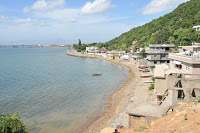
“Blanc!” a little boy cries out, smiling, as we ride by. A very grateful good bye to Randy, who stays to continue his amazing medical mission, and we will talk next week about our hemophilia national program. After an energy-draining, sweaty 90 minute wait in the airless passenger room, I am airborne on a small flight. I feel as though I am seated in a time machine about to come back to the present. I feel oddly guilty, as we in the US have so much, more than enough, more than we ever need. So much that it actually robs us of the incredible experience of life on the edge. Never have I felt so alive. Never have I felt as sad as to leave fellow humans behind in such conditions. And I cannot wait to return.


